Deck 17: Japan Before 1333
Question
Question
Question
Question
Question
Question
Question
Question
Question
Question
Question
Question
Question
Question
Question
Question
Question
Question
Question
Question
Question
Question
Question
Question
Question
Question
Question
Question
Question
Question
Question
Question
Question
Question
Question
Question
Question
Question
Question
Question
Question
Question
Question
Question
Question
Question
Question
Question
Question
Question

Unlock Deck
Sign up to unlock the cards in this deck!
Unlock Deck
Unlock Deck
1/50
Play
Full screen (f)
Deck 17: Japan Before 1333
1
What is the name of the sculptor who created the Shaka triad for the Horyuji Kondo?
A) Shunjobo Chogen
B) Lady Murasaki
C) Tori Busshi
D) Fujiwara Yorimichi
A) Shunjobo Chogen
B) Lady Murasaki
C) Tori Busshi
D) Fujiwara Yorimichi
C
2
Who is the deity associated with the Ise Shrine?
A) Buddha
B) Shaka
C) Vishnu
D) Amaterasu
A) Buddha
B) Shaka
C) Vishnu
D) Amaterasu
D
3
The Phoenix Hall, Byodoin, with its light exterior pillars, elevated wings, and reflective pond, is a physical metaphor for which of the following?
A) Kamakura imperial power
B) Buddha's palace in the Pure Land
C) Fujiwara clan
D) Buddha's Parinirvana
A) Kamakura imperial power
B) Buddha's palace in the Pure Land
C) Fujiwara clan
D) Buddha's Parinirvana
B
4
Which of the following roofing materials did the Japanese builders of the Kondo, or Golden Hall, of the Horyuji derive from the Chinese model?
A) Wood
B) Thatch
C) Ceramic tile
D) Marble
A) Wood
B) Thatch
C) Ceramic tile
D) Marble

Unlock Deck
Unlock for access to all 50 flashcards in this deck.
Unlock Deck
k this deck
5
During the Yayoi period, when villages grew in size and developed fortifications, people continued to live in which structures?
A) Haniwa houses
B) Mud huts
C) Stone houses
D) Pit dwellings
A) Haniwa houses
B) Mud huts
C) Stone houses
D) Pit dwellings

Unlock Deck
Unlock for access to all 50 flashcards in this deck.
Unlock Deck
k this deck
6
Which of the following are the earliest Japanese artworks?
A) Asuka Buddhist statues
B) Nara lacquer figures
C) Copies of Chinese Shang bronzes
D) Jomon ceramics
A) Asuka Buddhist statues
B) Nara lacquer figures
C) Copies of Chinese Shang bronzes
D) Jomon ceramics

Unlock Deck
Unlock for access to all 50 flashcards in this deck.
Unlock Deck
k this deck
7
Which of the following describes the funeral practices of the Kofun period?
A) Placing the dead in haniwa containers
B) Placing the dead atop sacred mountains
C) Placing the dead in palace-shaped sarcophagi
D) Placing the dead on stone biers
A) Placing the dead in haniwa containers
B) Placing the dead atop sacred mountains
C) Placing the dead in palace-shaped sarcophagi
D) Placing the dead on stone biers

Unlock Deck
Unlock for access to all 50 flashcards in this deck.
Unlock Deck
k this deck
8
During which period did close relations and exchanges with China shorten the time lag between developments in China and their transferal to Japan?
A) Yayoi
B) Nara
C) Jomon
D) Kamakura
A) Yayoi
B) Nara
C) Jomon
D) Kamakura

Unlock Deck
Unlock for access to all 50 flashcards in this deck.
Unlock Deck
k this deck
9
Which two cultures did the people of Japan have increased interaction with in the Yayoi period?
A) China and India
B) Korea and India
C) China and Korea
D) India and Tibet
A) China and India
B) Korea and India
C) China and Korea
D) India and Tibet

Unlock Deck
Unlock for access to all 50 flashcards in this deck.
Unlock Deck
k this deck
10
How often is the wooden Ise Shrine ritually rebuilt to maintain its spiritual purity?
A) Every 50 years
B) Every 20 years
C) Every century
D) Every millennium
A) Every 50 years
B) Every 20 years
C) Every century
D) Every millennium

Unlock Deck
Unlock for access to all 50 flashcards in this deck.
Unlock Deck
k this deck
11
During which period did the Korean ruler of Baekje send to the ruler of Japan a statue of Buddha and Buddhist scriptures?
A) Early Nara
B) Late Heian
C) Kamakura
D) Asuka
A) Early Nara
B) Late Heian
C) Kamakura
D) Asuka

Unlock Deck
Unlock for access to all 50 flashcards in this deck.
Unlock Deck
k this deck
12
How does the story told in the Tale of Genji handscrolls differ from that of Chinese prototypes such as Gu Kaizhi's Admonitions scroll?
A) It focuses on lessons in exemplary behaviors.
B) It focuses on emotionally charged personal relationships.
C) It focuses on imperial court etiquette as it relates to the empress.
D) It focuses on diplomatic relations between China and Japan.
A) It focuses on lessons in exemplary behaviors.
B) It focuses on emotionally charged personal relationships.
C) It focuses on imperial court etiquette as it relates to the empress.
D) It focuses on diplomatic relations between China and Japan.

Unlock Deck
Unlock for access to all 50 flashcards in this deck.
Unlock Deck
k this deck
13
Which artwork did a catastrophic fire destroy in 1949?
A) Decorated interior walls of the Phoenix Hall, Byodoin
B) Structure of Phoenix Hall, Byodoin
C) Structure Golden Hall, Horyuji
D) Decorated interior walls of the Golden Hall, Horyuji
A) Decorated interior walls of the Phoenix Hall, Byodoin
B) Structure of Phoenix Hall, Byodoin
C) Structure Golden Hall, Horyuji
D) Decorated interior walls of the Golden Hall, Horyuji

Unlock Deck
Unlock for access to all 50 flashcards in this deck.
Unlock Deck
k this deck
14
During the Kamakura period, there was more frequent and positive contact with China, bringing which of the following belief systems to Japan?
A) Tendai sect of Esoteric Buddhism
B) Shingon sect of Esoteric Buddhism
C) Zen (Chan) Buddhism
D) Legalism sect of Confucianism
A) Tendai sect of Esoteric Buddhism
B) Shingon sect of Esoteric Buddhism
C) Zen (Chan) Buddhism
D) Legalism sect of Confucianism

Unlock Deck
Unlock for access to all 50 flashcards in this deck.
Unlock Deck
k this deck
15
The Legends of Mount Shigi represents a type of narrative handscroll painting belonging to which of the following genres?
A) Erotic court tales
B) Japanese travel journals
C) Histories of the Nara court
D) Pious Buddhist tales
A) Erotic court tales
B) Japanese travel journals
C) Histories of the Nara court
D) Pious Buddhist tales

Unlock Deck
Unlock for access to all 50 flashcards in this deck.
Unlock Deck
k this deck
16
What was the first artistic development of the Jomon culture?
A) Bronze-casting
B) Ceramic technology
C) Yamato-e painting
D) Agriculture
A) Bronze-casting
B) Ceramic technology
C) Yamato-e painting
D) Agriculture

Unlock Deck
Unlock for access to all 50 flashcards in this deck.
Unlock Deck
k this deck
17
Paintings and sculptures of the Amida Buddha descending with a retinue to greet his followers were popular with members of which of the following sects?
A) Esoteric sects
B) Maitreya sects
C) Paradise sects
D) Hinayana sects
A) Esoteric sects
B) Maitreya sects
C) Paradise sects
D) Hinayana sects

Unlock Deck
Unlock for access to all 50 flashcards in this deck.
Unlock Deck
k this deck
18
What was the earliest art-producing culture to develop in Japan?
A) Nara
B) Heian
C) Yayoi
D) Jomon
A) Nara
B) Heian
C) Yayoi
D) Jomon

Unlock Deck
Unlock for access to all 50 flashcards in this deck.
Unlock Deck
k this deck
19
The standard shape for the central mound of tumuli during the Kofun period is which of the following?
A) Beehive
B) Wedge
C) Triangular
D) Keyhole
A) Beehive
B) Wedge
C) Triangular
D) Keyhole

Unlock Deck
Unlock for access to all 50 flashcards in this deck.
Unlock Deck
k this deck
20
Who were the first users of hiragana script, which became the primary medium for writing court poetry during the Heian period?
A) Court administrators
B) Samurai warriors
C) Women of the court
D) Buddhist monks
A) Court administrators
B) Samurai warriors
C) Women of the court
D) Buddhist monks

Unlock Deck
Unlock for access to all 50 flashcards in this deck.
Unlock Deck
k this deck
21
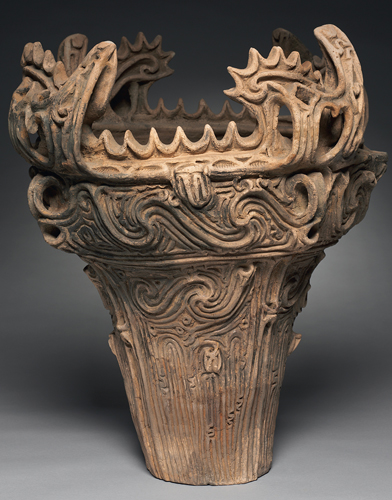
Which artistic period produced this flame-style vessel?
A) Heian
B) Kofun
C) Kamakura
D) Jomon

Which artistic period produced this flame-style vessel?
A) Heian
B) Kofun
C) Kamakura
D) Jomon

Unlock Deck
Unlock for access to all 50 flashcards in this deck.
Unlock Deck
k this deck
22
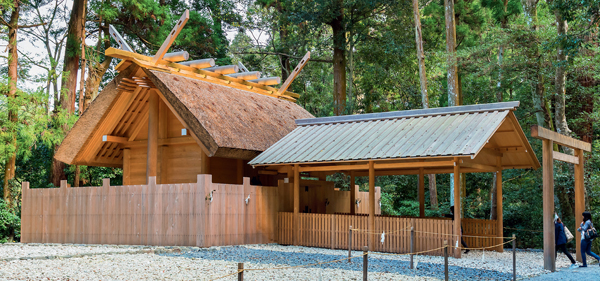
Which structure appears in this image?
A) Phoenix Hall
B) Katsura Imperial Villa
C) Ise Shrine
D) Kondo (Golden Hall)

Which structure appears in this image?
A) Phoenix Hall
B) Katsura Imperial Villa
C) Ise Shrine
D) Kondo (Golden Hall)

Unlock Deck
Unlock for access to all 50 flashcards in this deck.
Unlock Deck
k this deck
23
The style of the Yakushi triad can be traced back to its origin in which area?
A) Korea
B) India
C) China
D) Java
A) Korea
B) India
C) China
D) Java

Unlock Deck
Unlock for access to all 50 flashcards in this deck.
Unlock Deck
k this deck
24
What device does the artist of the illustrations in the Tale of Genji handscrolls use to show the interior space of a building?
A) Shows only the interior space, no exterior
B) Paints the room with no ceiling or roof
C) Paints interior in bright colors, exterior black ink lines only
D) Paints figures as if on a stage, with no ceiling or walls
A) Shows only the interior space, no exterior
B) Paints the room with no ceiling or roof
C) Paints interior in bright colors, exterior black ink lines only
D) Paints figures as if on a stage, with no ceiling or walls

Unlock Deck
Unlock for access to all 50 flashcards in this deck.
Unlock Deck
k this deck
25
Iron-wire lines are an aspect of which Japanese art form?
A) Woodcutting
B) Sculpture
C) Painting
D) Weaving
A) Woodcutting
B) Sculpture
C) Painting
D) Weaving

Unlock Deck
Unlock for access to all 50 flashcards in this deck.
Unlock Deck
k this deck
26
Which artist created the bronze Shaka triad now in the kondo of the Horyuji complex?
A) Shunjobo Chogen
B) Tori Busshi
C) Yakushi Nikko
D) Koken-Shotuku
A) Shunjobo Chogen
B) Tori Busshi
C) Yakushi Nikko
D) Koken-Shotuku

Unlock Deck
Unlock for access to all 50 flashcards in this deck.
Unlock Deck
k this deck
27
Which of the following is an artwork in the tradition of Shingon Buddhism?
A) Amida triad
B) Ise Jingu honden
C) Taizokai mandara
D) Ishiyama-gire
A) Amida triad
B) Ise Jingu honden
C) Taizokai mandara
D) Ishiyama-gire

Unlock Deck
Unlock for access to all 50 flashcards in this deck.
Unlock Deck
k this deck
28
Which sculptural style was prevalent in the Kamakura period?
A) Idealism
B) Realism
C) Abstraction
D) Primitivism
A) Idealism
B) Realism
C) Abstraction
D) Primitivism

Unlock Deck
Unlock for access to all 50 flashcards in this deck.
Unlock Deck
k this deck
29
Which of the following has NOT been suggested as an identification of the Kofun haniwa figures set up around burial mounds?
A) Tomb guardians
B) Funeral procession
C) Dwellers in the realm
D) Family of the deceased
A) Tomb guardians
B) Funeral procession
C) Dwellers in the realm
D) Family of the deceased

Unlock Deck
Unlock for access to all 50 flashcards in this deck.
Unlock Deck
k this deck
30
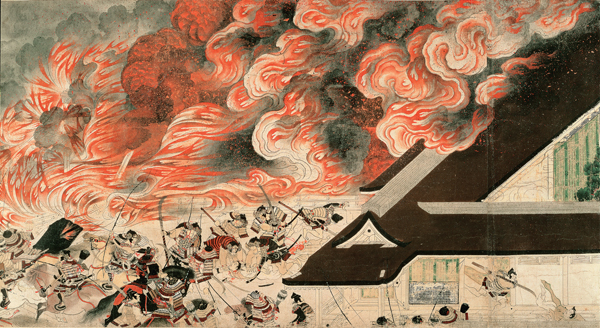
What is the subject of this ink-and-color handscroll illustration?
A) Legends of Mount Shigi
B) Genji Visits Murasaki
C) Night Attack on the Sanjo Palace
D) Events of the Heiji Period

What is the subject of this ink-and-color handscroll illustration?
A) Legends of Mount Shigi
B) Genji Visits Murasaki
C) Night Attack on the Sanjo Palace
D) Events of the Heiji Period

Unlock Deck
Unlock for access to all 50 flashcards in this deck.
Unlock Deck
k this deck
31
Which Nara period building saw Buddhist dignitaries from China and India attend its dedication?
A) Kondo, Horyuji
B) Daibutsuden, Todaiji
C) Honden, Ise Jungu
D) Kondo, Yakushiji
A) Kondo, Horyuji
B) Daibutsuden, Todaiji
C) Honden, Ise Jungu
D) Kondo, Yakushiji

Unlock Deck
Unlock for access to all 50 flashcards in this deck.
Unlock Deck
k this deck
32
In Japanese sacred architecture, pagodas served as which of the following?
A) Shinto shrines
B) Temples
C) Schools
D) Shelter for relics
A) Shinto shrines
B) Temples
C) Schools
D) Shelter for relics

Unlock Deck
Unlock for access to all 50 flashcards in this deck.
Unlock Deck
k this deck
33
What was the original inspiration for the form of the main hall ( honden ) at the shrine of Ise Jingu?
A) Indian stupa
B) Han temple
C) Early granary
D) Jomon house
A) Indian stupa
B) Han temple
C) Early granary
D) Jomon house

Unlock Deck
Unlock for access to all 50 flashcards in this deck.
Unlock Deck
k this deck
34
What construction method was used to construct the Ise Shrine?
A) Wattle-and-daub system
B) Post-and-lintel system
C) Staggered-truss system
D) Mortise-and-tenon system
A) Wattle-and-daub system
B) Post-and-lintel system
C) Staggered-truss system
D) Mortise-and-tenon system

Unlock Deck
Unlock for access to all 50 flashcards in this deck.
Unlock Deck
k this deck
35
During the Kamakura period, which social group became the dominant sociopolitical force in Japan?
A) Imperial court
B) Priesthood
C) Shogunate
D) Chinese immigrants
A) Imperial court
B) Priesthood
C) Shogunate
D) Chinese immigrants

Unlock Deck
Unlock for access to all 50 flashcards in this deck.
Unlock Deck
k this deck
36
In what artistic tradition did the Kei School train its members?
A) Ceramics
B) Painting
C) Sculpture
D) Embroidery
A) Ceramics
B) Painting
C) Sculpture
D) Embroidery

Unlock Deck
Unlock for access to all 50 flashcards in this deck.
Unlock Deck
k this deck
37
Which Heian period clan had a strong influence in the imperial court over several generations?
A) Taizokai
B) Minamoto
C) Shunjobo
D) Fujiwara
A) Taizokai
B) Minamoto
C) Shunjobo
D) Fujiwara

Unlock Deck
Unlock for access to all 50 flashcards in this deck.
Unlock Deck
k this deck
38
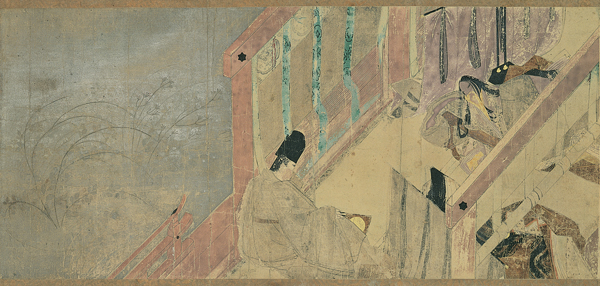
From which larger work does this scene derive?
A) Legends of Mount Shigi
B) The Tale of Genji handscrolls
C) Ishiyama-gire
D) Events of the Heiji Period

From which larger work does this scene derive?
A) Legends of Mount Shigi
B) The Tale of Genji handscrolls
C) Ishiyama-gire
D) Events of the Heiji Period

Unlock Deck
Unlock for access to all 50 flashcards in this deck.
Unlock Deck
k this deck
39
In the Tale of Genji handscrolls, which plant came to symbolize fading life and love and the season of autumn?
A) Cherry blossom
B) Peony
C) Bush-clover
D) Chrysanthemum
A) Cherry blossom
B) Peony
C) Bush-clover
D) Chrysanthemum

Unlock Deck
Unlock for access to all 50 flashcards in this deck.
Unlock Deck
k this deck
40
In what medium did the Kamakura sculptor Kosho fashion his figures, such as the Buddhist priest Kuya?
A) Stone
B) Wood
C) Clay
D) Bronze
A) Stone
B) Wood
C) Clay
D) Bronze

Unlock Deck
Unlock for access to all 50 flashcards in this deck.
Unlock Deck
k this deck
41
What was the original function of a pagoda in Japanese Buddhist architecture?
A) Serve as hall for readings of scripture
B) Shelter the image of the Buddha and attendants
C) Provide a monumental entrance gateway
D) House relics of the Buddha
A) Serve as hall for readings of scripture
B) Shelter the image of the Buddha and attendants
C) Provide a monumental entrance gateway
D) House relics of the Buddha

Unlock Deck
Unlock for access to all 50 flashcards in this deck.
Unlock Deck
k this deck
42
What type of artwork served as an aid to meditation and visualization in Shingon Buddhism?
A) Handscroll
B) Dotaku
C) Nembutsu
D) Mandara
A) Handscroll
B) Dotaku
C) Nembutsu
D) Mandara

Unlock Deck
Unlock for access to all 50 flashcards in this deck.
Unlock Deck
k this deck
43
Who was the sculptor of the wooden statue of the Amida in the Phoenix Hall?
A) Tori Bosshi
B) Jocho
C) Kosho
D) Kuya
A) Tori Bosshi
B) Jocho
C) Kosho
D) Kuya

Unlock Deck
Unlock for access to all 50 flashcards in this deck.
Unlock Deck
k this deck
44
In what year do historians believe Buddhism arrived in Japan?
A) 401
B) 757
C) 552
D) 253
A) 401
B) 757
C) 552
D) 253

Unlock Deck
Unlock for access to all 50 flashcards in this deck.
Unlock Deck
k this deck
45
In what script were the Tale of Genji handscrolls originally written?
A) Romaji
B) Katakana
C) Hiragana
D) Kanji
A) Romaji
B) Katakana
C) Hiragana
D) Kanji

Unlock Deck
Unlock for access to all 50 flashcards in this deck.
Unlock Deck
k this deck
46
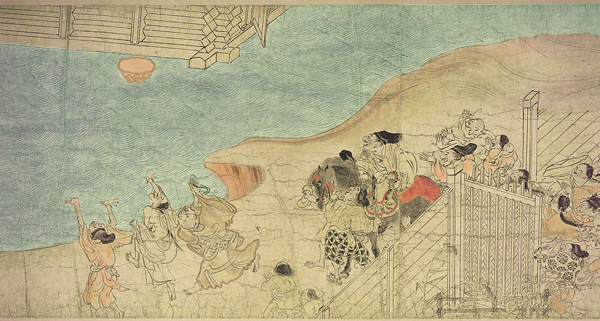
What is the title of the narrative work from which this illustration is drawn?
A) Tale of Genji
B) Legends of Mount Shigi
C) Thirty-Six Immortal Poets
D) Events of Heiji Period

What is the title of the narrative work from which this illustration is drawn?
A) Tale of Genji
B) Legends of Mount Shigi
C) Thirty-Six Immortal Poets
D) Events of Heiji Period

Unlock Deck
Unlock for access to all 50 flashcards in this deck.
Unlock Deck
k this deck
47
The painting Night Attack on the Sanjo Palace tells the narrative of events in which period?
A) Kofun
B) Nara
C) Heian
D) Yayoi
A) Kofun
B) Nara
C) Heian
D) Yayoi

Unlock Deck
Unlock for access to all 50 flashcards in this deck.
Unlock Deck
k this deck
48
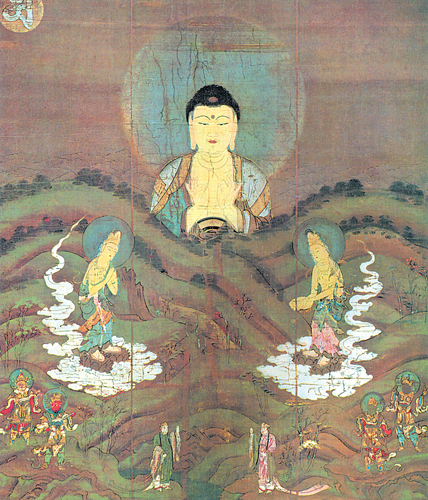
What is the subject of this scene on a hanging scroll?
A) Priest Kuya Preaching
B) Diamond World
C) Birth of the Buddh a
D) Amida Descending over the Mountains

What is the subject of this scene on a hanging scroll?
A) Priest Kuya Preaching
B) Diamond World
C) Birth of the Buddh a
D) Amida Descending over the Mountains

Unlock Deck
Unlock for access to all 50 flashcards in this deck.
Unlock Deck
k this deck
49
Which individual guided the reconstruction the temple of Todaiji in the Kamakura period?
A) Kosho
B) Shunjobo Chogen
C) Koken-Shotuku
D) Murasaki Shikubu
A) Kosho
B) Shunjobo Chogen
C) Koken-Shotuku
D) Murasaki Shikubu

Unlock Deck
Unlock for access to all 50 flashcards in this deck.
Unlock Deck
k this deck
50
Which of the following would NOT be considered a formal feature of yamato-e painting?
A) Lack of emphasis on brushwork
B) Individualization of features
C) Bright mineral pigments
D) Native Japanese subjects
A) Lack of emphasis on brushwork
B) Individualization of features
C) Bright mineral pigments
D) Native Japanese subjects

Unlock Deck
Unlock for access to all 50 flashcards in this deck.
Unlock Deck
k this deck



